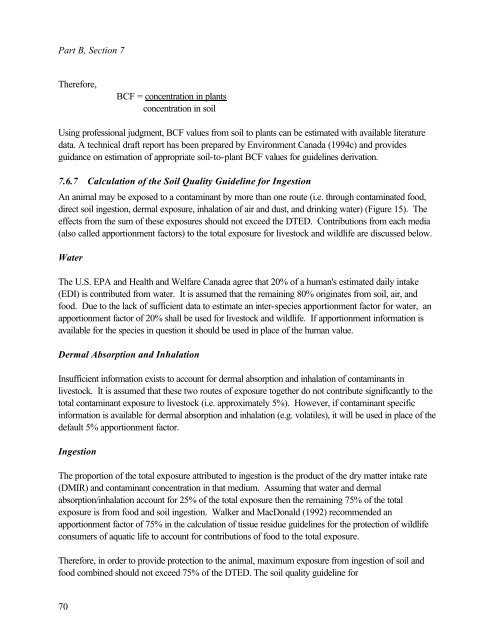Protocol for the Derivation of Environmental and Human ... - CCME
Protocol for the Derivation of Environmental and Human ... - CCME
Protocol for the Derivation of Environmental and Human ... - CCME
You also want an ePaper? Increase the reach of your titles
YUMPU automatically turns print PDFs into web optimized ePapers that Google loves.
Part B, Section 7<br />
There<strong>for</strong>e,<br />
BCF = concentration in plants<br />
concentration in soil<br />
Using pr<strong>of</strong>essional judgment, BCF values from soil to plants can be estimated with available literature<br />
data. A technical draft report has been prepared by Environment Canada (1994c) <strong>and</strong> provides<br />
guidance on estimation <strong>of</strong> appropriate soil-to-plant BCF values <strong>for</strong> guidelines derivation.<br />
7.6.7 Calculation <strong>of</strong> <strong>the</strong> Soil Quality Guideline <strong>for</strong> Ingestion<br />
An animal may be exposed to a contaminant by more than one route (i.e. through contaminated food,<br />
direct soil ingestion, dermal exposure, inhalation <strong>of</strong> air <strong>and</strong> dust, <strong>and</strong> drinking water) (Figure 15). The<br />
effects from <strong>the</strong> sum <strong>of</strong> <strong>the</strong>se exposures should not exceed <strong>the</strong> DTED. Contributions from each media<br />
(also called apportionment factors) to <strong>the</strong> total exposure <strong>for</strong> livestock <strong>and</strong> wildlife are discussed below.<br />
Water<br />
The U.S. EPA <strong>and</strong> Health <strong>and</strong> Welfare Canada agree that 20% <strong>of</strong> a human's estimated daily intake<br />
(EDI) is contributed from water. It is assumed that <strong>the</strong> remaining 80% originates from soil, air, <strong>and</strong><br />
food. Due to <strong>the</strong> lack <strong>of</strong> sufficient data to estimate an inter-species apportionment factor <strong>for</strong> water, an<br />
apportionment factor <strong>of</strong> 20% shall be used <strong>for</strong> livestock <strong>and</strong> wildlife. If apportionment in<strong>for</strong>mation is<br />
available <strong>for</strong> <strong>the</strong> species in question it should be used in place <strong>of</strong> <strong>the</strong> human value.<br />
Dermal Absorption <strong>and</strong> Inhalation<br />
Insufficient in<strong>for</strong>mation exists to account <strong>for</strong> dermal absorption <strong>and</strong> inhalation <strong>of</strong> contaminants in<br />
livestock. It is assumed that <strong>the</strong>se two routes <strong>of</strong> exposure toge<strong>the</strong>r do not contribute significantly to <strong>the</strong><br />
total contaminant exposure to livestock (i.e. approximately 5%). However, if contaminant specific<br />
in<strong>for</strong>mation is available <strong>for</strong> dermal absorption <strong>and</strong> inhalation (e.g. volatiles), it will be used in place <strong>of</strong> <strong>the</strong><br />
default 5% apportionment factor.<br />
Ingestion<br />
The proportion <strong>of</strong> <strong>the</strong> total exposure attributed to ingestion is <strong>the</strong> product <strong>of</strong> <strong>the</strong> dry matter intake rate<br />
(DMIR) <strong>and</strong> contaminant concentration in that medium. Assuming that water <strong>and</strong> dermal<br />
absorption/inhalation account <strong>for</strong> 25% <strong>of</strong> <strong>the</strong> total exposure <strong>the</strong>n <strong>the</strong> remaining 75% <strong>of</strong> <strong>the</strong> total<br />
exposure is from food <strong>and</strong> soil ingestion. Walker <strong>and</strong> MacDonald (1992) recommended an<br />
apportionment factor <strong>of</strong> 75% in <strong>the</strong> calculation <strong>of</strong> tissue residue guidelines <strong>for</strong> <strong>the</strong> protection <strong>of</strong> wildlife<br />
consumers <strong>of</strong> aquatic life to account <strong>for</strong> contributions <strong>of</strong> food to <strong>the</strong> total exposure.<br />
There<strong>for</strong>e, in order to provide protection to <strong>the</strong> animal, maximum exposure from ingestion <strong>of</strong> soil <strong>and</strong><br />
food combined should not exceed 75% <strong>of</strong> <strong>the</strong> DTED. The soil quality guideline <strong>for</strong><br />
70
















